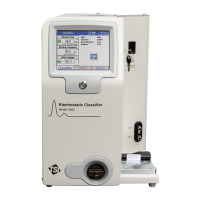Safety vii
W A R N I N G
The Model 3077/3077A Neutralizer contains radioactive material that is
subject to the regulations of the U.S. Nuclear Regulatory Commission
as well as local regulations.
The Model 3088 Advanced Aerosol Neutralizer contains an x-ray
source, which may be subject to local regulations. During normal
operation, you will not be exposed to x-ray radiation. Do not make any
changes to the Aerosol Neutralizer such as detaching the x-ray source
from the neutralizer tube.
Chem i c a l S afety
The SMPS spectrometer can be used with a Model 3088 Advanced
Aerosol Neutralizer. The x-ray source in the Model 3088 contains a window
that is made from beryllium. In normal operation this window is not
accessible. However, should this window be damaged or broken, turn off
the power and then contact TSI for proper disposal instructions. Beryllium
fragments or dust particles produced by a broken output window are
harmful to the body, so take extreme caution not to inhale them. When the
x-ray source is to be disposed of, contact TSI for proper disposal
instructions.
Some of the CPCs that can be used in a 3938 SMPS spectrometer use n-
butyl alcohol (butanol) as a working fluid (models 3772, 3775, 3776).
Butanol is flammable and potentially toxic if inhaled. When using butanol,
refer to a material safety sheet and follow these precautions:
Use butanol in a well-ventilated area.
If you smell butanol (it has a strong odor) and develop a headache, or
feel faint or nauseous, leave the area at once. Ventilate the area before
returning.
The Model 3777 Nano Enhancer uses Diethylene glycol (DEG) as a
working fluid. While overall less toxic and corrosive than other working
fluids such as butanol, DEG can be toxic if ingested in or inhaled. Refer to
a Safety Data Sheet for proper precautions when handling DEG.
Use DEG in a well-ventilated area.
W A R N I N G
Butanol is flammable. Butanol is also potentially toxic if inhaled. If you
smell butanol and develop a headache, or feel faint or nauseous, leave
the area at once. Ventilate the area before returning.
W A R N I N G
DEG is potentially toxic if inhaled or ingested. Use DEG only in a well-
ventilated area.

